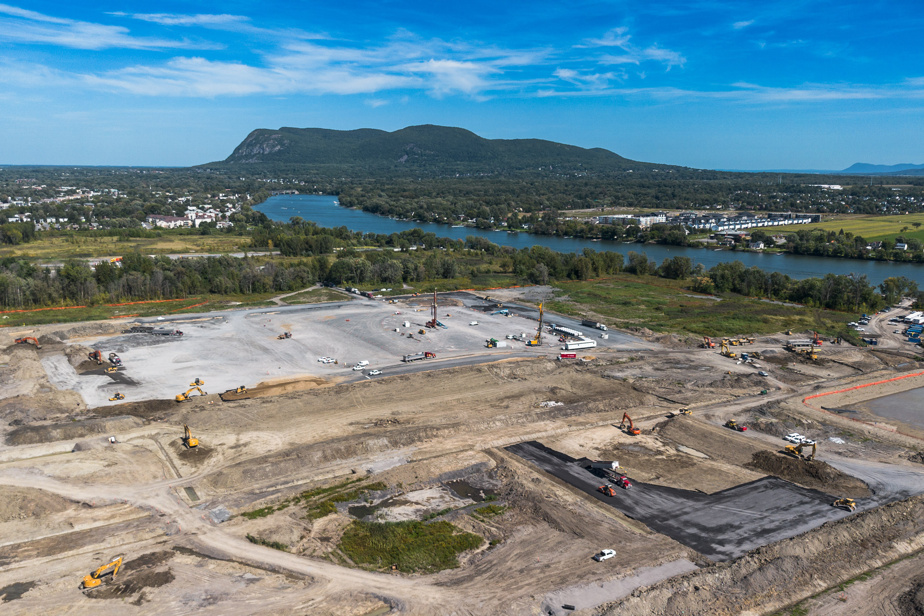“Low”, “moderate”, “high” and “very high” risk flood zones are located on the land where Northvolt will be located, according to maps posted online this week by the Montreal Metropolitan Community (CMM). ). The construction of industrial buildings in these areas worries the director of the Quebec Intersectoral Flood Network.
The maps put online by the CMM last Monday allow the user to discover in which risk category a sector or neighborhood would be located, according to the flood zone regulation project proposed by Quebec and which must be adopted this fall.
There are four flood risk categories in the new regulations: low, moderate, high and very high and each risk corresponds to a color on the map.
However, the Northvolt land, with an area of 170 hectares, contains the four colors.
When we superimpose the new preliminary mapping with the map which contains the places where Northvolt wants to build its buildings in Saint-Basile-le-Grand and McMasterville, “we realize that part of the building which will be used for battery recycling finds itself in the high or very high risk zone,” observed with concern Philippe Gachon, professor of hydroclimatology at UQAM.
The Northvolt recycling plant, to which the professor refers, is the only part of the project that will be submitted to the Office of Public Hearings on the Environment (BAPE).
Ministerial authorization
The regulations planned by Quebec would prohibit the construction of new residential buildings in flood zones.
However, the draft regulation differs with regard to non-residential buildings.
The construction of this type of building would be “prohibited”, but would be “possible” by “ministerial authorization”, according to the draft regulation.
Professor Gachon is of the opinion that this type of building should be prohibited in flood zones.
“This is very worrying, especially for industrial buildings which can, possibly if they are flooded, pose safety problems for people, but also in terms of potential risk of contamination on the environment”, indicated the one who is also director of the Quebec Intersectoral Flood Network (RIIQ), a group of 200 researchers whose mission is to improve Quebec’s capacity to prepare for floods.
“The Richelieu River is the source of drinking water for around 80,000 people downstream from the factory” and “the drinking water intake is located around 500 meters from the land,” added Philipe Gachon, who fears discharges. nickel, cobalt or lithium in water in the event of major flooding.
“Perhaps there is a part of the land which could possibly be developable, but not at the moment, near the river, especially for a building which will be used to recycle batteries and which could potentially be risk if it ever finds itself underwater, unless special arrangements are made, such as to completely remove this risk,” he added.
Land flooded in 2011
Philipe Gachon lives less than a kilometer from the Northvolt grounds and he still remembers the flooding of the Richelieu River in 2011, when thousands of homes were evacuated and the Canadian Armed Forces had to come to the aid of the population.
At the time, the land now owned by Northvolt was flooded.
This sector had “absorbed” and “swept up a lot of water” due to these wetlands, indicated Philippe Gachon.
“But we destroyed a wetland which was among the most important remaining in the Richelieu valley”, which had the consequence of “putting the region even more at risk in the event of a major flood”, according to him.
Northvolt representatives were not available for an interview on the subject Friday, but communications manager Emmanuelle Rouillard-Moreau indicated, in an email, that the company “took flood zones into account in the design of the complex , while going beyond the regulations currently in force in order to be able to cope with climate change, greater floods or possible changes in regulations.
The Ministry of the Environment, for its part, also indicated in writing that “all Northvolt activities requiring authorization are analyzed according to the applicable regulations and the analysis takes into account the presence of flood zones”.
Preliminary maps
On Northvolt land, areas identified as being at risk of flooding according to CMM maps border the Richelieu River.
In some places, these zones extend a few dozen meters from the shore, but in other places on the property, they extend up to 100 or even 200 meters from the shore, according to maps. the CMM.
In an email exchange, a spokesperson for the Ministry of the Environment recalled that “the maps distributed by the CMM are not official and have not been adopted”.
These are in fact “preliminary maps”, which the Metropolitan Community of Montreal created using the methodology of the regulation proposed by Quebec.
At the beginning of the summer, the Quebec government launched a public consultation, which must end on October 17, on the new regulations concerning flood zones, which includes the new mapping.
According to “traditional” flood zone mapping, the land owned by Northvolt has recurrence ratings of “0-20 years” and “20-100 years”.
The new mapping, which is more precise and contains four levels of risk, is necessary for the entire province, according to the government, in particular because of climate change, the increase in the frequency of major floods and the socio-economic costs that are associated with it.
